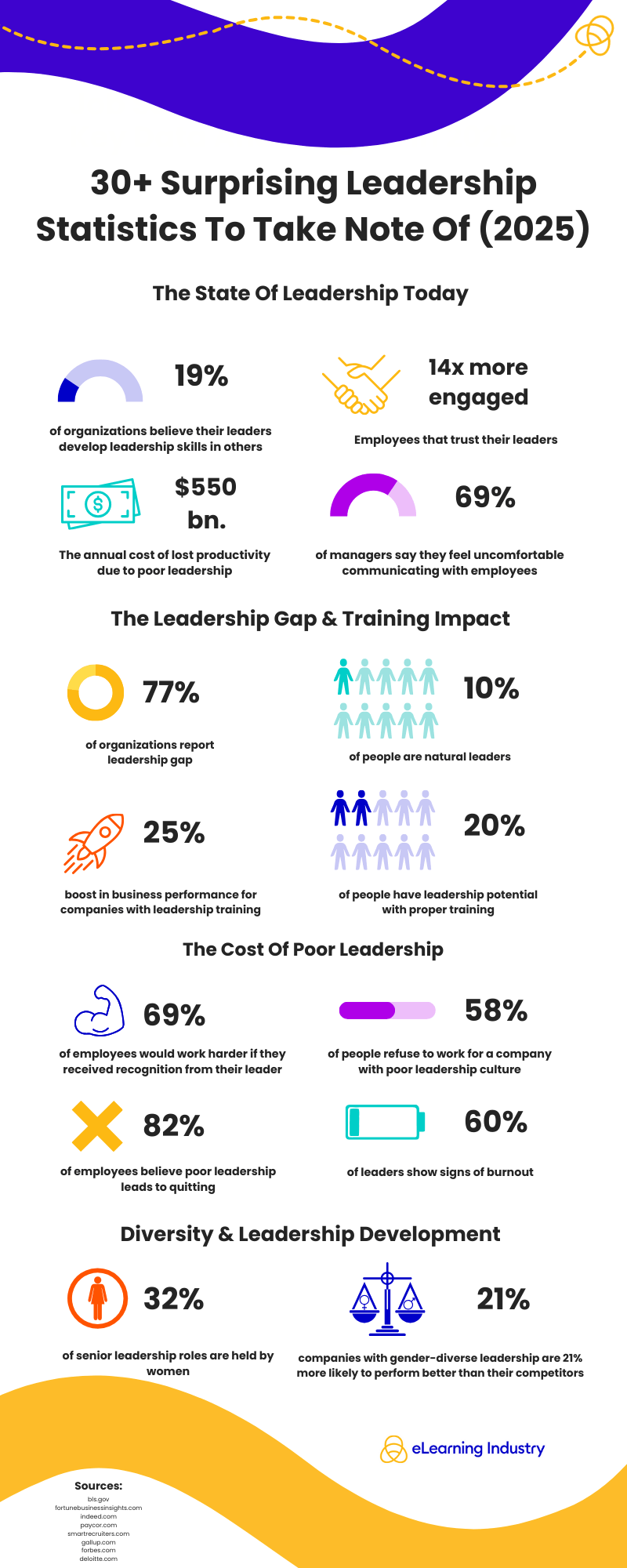Most people don’t realize what a leader’s job truly entails. Some think that they’re just leading a bunch of people who do their work for them, but this is far from the case. While it seems quite a convenient job from a superficial standpoint, if you look closely, you’ll find that it’s actually more demanding than that. Leadership involves managing different types of employees, empathizing with them, and creating a flexible environment in which they thrive. It requires mental resilience and the ability to stay calm under pressure, involving many more challenges than one can guess from the get-go. To gauge the situation in its entirety, let’s explore some leadership-related statistics surrounding the challenges, essential qualities, state, impact, etc., of a leader’s role in 2025 and beyond.
What’s Inside This Guide…
The State Of Leadership Today
The dynamics of leadership have changed dramatically. It’s no longer a job just about giving orders but about inspiring, adapting, and driving results in a business world full of disruption and change. Studies are showing that the leadership gap is real, with 77% of organizations struggling with leadership gaps at all levels. What’s worse, only a mere 19% of organizations believe that their leaders are good at developing leadership skills in others. That’s a problem, especially if we consider that poor leadership can cost businesses up to $550 billion annually in lost productivity.
The workforce is changing, and so are expectations. Employees want leaders who are empathetic, transparent, and inclusive. In fact, employees who trust their leaders are 14 times more engaged. Yet, only 15% of employees worldwide feel truly engaged at work. There’s a disconnect, and it’s hurting retention.
Moreover, as remote and hybrid work models have reshaped leadership, managing teams from afar requires a different skillset that many leaders struggle to master. A shocking 69% of managers [1] say they’re uncomfortable communicating with employees, which is a huge issue in a digital-first world.
Though tech and AI have reached an inflection point, human intervention shouldn’t be ignored. With AI automating tasks, leaders need to focus on emotional intelligence, problem solving, and strategic thinking. The best leaders of today aren’t just decision-makers—they’re coaches, mentors, and visionaries. The bottom line here is that leadership today is no longer about authority but about impact. Organizations that invest in leadership development will thrive, and those that don’t are at risk of falling behind in a world that demands more from its leaders than ever before.
What Talents Do Great Leaders Have?
Great leaders aren’t just born—they’re built through experience, self-awareness, and continuous learning. So, what sets them apart? Here’s a look at a few great leaders and their qualities.
Leaders Are Visionaries
Great leaders possess vision. They see the bigger picture and make others visualize it, too, inspiring them to work toward it. Martin Luther King Jr.’s “I Have a Dream” speech wasn’t just words; it was a vision that galvanized a movement. In leadership, clarity of purpose is key.
Leaders Are Master Communicators
Without a talent for communication, you can’t be a great leader like Steve Jobs. In his product launches, he used such exemplary communication skills that it felt like he wasn’t just selling tech; he was selling a dream, a lifestyle. He connected with his audience on an emotional level.
Leaders Are Sharp Decision-Makers
Leaders don’t succumb to pressure. They weigh the facts, trust their instincts, and take decisive action, just like Winston Churchill during the World War II era. Through his unwavering resolve and decision-making prowess, he managed to turn the tide of the war and became one of the most influential and steadfast figures of the 20th century.
Leaders Are Empathetic
Empathy is another vital ingredient. Leaders who understand and acknowledge their team’s feelings build trust and loyalty. Jacinda Ardern, Prime Minister of New Zealand, exemplifies this. Her compassionate response to tragedies resonated globally. She showed the world that strength and empathy can coexist.
Leaders Are Resilient
Resilience is essential for every leader. Setbacks are inevitable, but great leaders bounce back. They learn from their mistakes and keep moving forward, inspiring their teams to do the same. Think of Abraham Lincoln, who faced numerous defeats before leading the United States through its Civil War.
Hence, if we were to talk about essential leadership qualities, we’d focus on these: true leaders empower others, without micromanaging them. They delegate, mentor, and create opportunities for growth, knowing that their success depends on the success of their team. They nurture talent and build future leaders, because it’s all about leaving a legacy.
Leadership Training Statistics
Great leaders aren’t born overnight. Most of the time, they’re built with training, mentorship, and hands-on experience. But how many actually receive opportunities for proper leadership development? The numbers tell an interesting story.
- Around 77% of organizations report a leadership gap—meaning they lack strong leadership at various levels.
- Only 10% of people are natural leaders, while 20% show leadership potential with proper training.
- Companies that offer leadership training see a 25% boost in business performance and a 20% increase in overall performance on average.
- Despite these benefits, 58% of managers say they never received any formal leadership training.
The takeaway here is that training isn’t just an optional luxury but a prerequisite to building great leaders. Organizations that adapt to the corporate leadership training market create stronger, more confident teams and outperform competitors. Basically, if companies want future-ready leaders, they need to start building them today.
Business Leadership Statistics
Strong leadership fuels organizational success. But what do the numbers say about leadership effectiveness?
- 69% of employees say they’d work harder if their leaders recognized their efforts.
- Companies with strong leadership are 2.3 times more likely to outperform competitors financially.
- 82% of employees believe poor leadership leads to disengagement, making them consider quitting their jobs.
- Beyond being a major internal issue, poor leadership also affects reputation. 58% of people say they won’t work for a company with a bad leadership culture.
Leadership isn’t just about managing people—it’s about inspiring them. Strong leaders create engaged teams, drive results, and keep businesses thriving.
Leadership Burnout Statistics
Leading isn’t easy. The pressure to perform, make decisions, and keep teams motivated takes a toll, and the stats on leadership burnout are eye-opening.
- 60% of leaders feel exhausted at the end of the workday, a clear sign of burnout.
- Burnout doesn’t just drain you mentally—it affects your physical health, too. 79% of employees agree they have work-related stress. Among these employees, 44% of them report physical fatigue, while 36% experience mental fatigue.
- Leadership burnout equally affects individuals and businesses. Burned-out leaders are 2.6 times more likely to leave their jobs.
- 68% of employees say they suffer from work overload.
- Approximately 50% of leaders feel overwhelmed, leading to poor decision making and decreased performance.
Burnout is a warning sign, not a badge of honor. Companies need to prioritize leader well-being by promoting work-life balance, offering support, and encouraging downtime.
Leadership Stress Statistics
An important part of being a leader lies in handling stress under pressure, not just making big decisions. The numbers show just how much stress leaders carry.
- 44% of managers managing more than 31 employees are extremely stressed. Meanwhile, only 16% of managers feel stressed if they’re leading 1 to 5 employees.
- 75% of employees believe their leader’s stress affects team morale and performance.
- 48% of workers call themselves “workaholics,” while 66% of them skip one meal per day due to working hours.
- Nearly 3 in 4 middle managers feel overwhelmed at work, highlighting the need for better support and training.
- Stress doesn’t just stay at work. 76% of leaders say work stress affects their personal relationships.
The message is clear. Leadership is tough, but it shouldn’t be unbearable. Organizations must provide tools, mentorship, and mental health resources to help leaders handle stress effectively.
Leadership Development Statistics
Leadership is a journey. But are organizations doing enough to develop their leaders? Let’s look at the stats.
- Only 29% of employees say their leader is ready to embrace outside ideas and practices.
- 63% of millennials feel they aren’t receiving enough leadership training for future roles.
- Companies that invest in leadership development are far more likely to achieve financial success.
- 58% of employees say they would stay longer at a company that offers leadership growth opportunities.
Organizations that fail to develop leaders risk losing top talent. Investing in leadership growth shouldn’t be optional. It’s a prerequisite for long-term success.
Women Leadership Statistics
Women continue to break barriers in leadership, but sadly, the statistics show that there’s still a long way to go.
- As of 2023, women account for 41.9% of the entire workforce worldwide. However, they lead only 32.2% of senior leadership positions worldwide.
- Companies with gender-diverse leadership teams are 21% more likely to outperform competitors.
- 60% of women say they face more scrutiny than their male counterparts in leadership roles.
- Despite making up nearly 42% of the workforce, women still earn only 84 cents for every dollar earned by men in leadership.
Progress is happening, but businesses must do more to support and empower women leaders. Providing equal opportunities will lead to the creation of more innovative teams.

Statistics On Leadership Challenges
Even great leaders face obstacles. But what are the most common challenges they encounter?
- 45% of CEOs are afraid that their company will not survive more than a decade on its current path.
- 37% of managers admit they find giving honest, constructive feedback difficult. [1]
- 37% of leaders believe the main obstacle is failing to adapt the operating model enough.
Leadership isn’t easy, but acknowledging these challenges helps organizations build better support systems for their leaders.
Leadership Skills And Qualities Statistics
What makes a truly great leader? Though we’ve already discussed it above, let’s look at this from a statistical point of view:
- 85% of business success is attributed to soft skills like communication, adaptability, and emotional intelligence.
- 92% of employees say they’re more likely to stay at a company with empathetic leadership.
- 70% of executives believe creativity and problem solving are the most valuable leadership traits.
Great leadership isn’t about titles—it’s about building trust, inspiring teams, and continuously improving.
Leadership Impact On Company Culture
Leadership plays a massive role in shaping company culture. Sure, goal setting is essential, but we need to focus on creating an environment where people want to achieve said goals. In this context, leaders become the architects of culture because their actions, words, and even their moods set the tone. Therefore, if leaders prioritize transparency, employees are more likely to be open and honest. If they value collaboration, teamwork thrives. In short, great leaders pass on their traits to others and build more leaders for their business.
And yet, a Gallup study found that only 54% of employees feel their leader knows what they do in their day-to-day. That’s a huge missed opportunity. Leaders who understand their team’s work, challenges, and contributions build stronger relationships. When employees feel supported by their leader, they’re three times more likely to be engaged.
Leaders also communicate the company’s vision and mission. Employees who understand the bigger picture feel more connected to their work. This translates to a 27% increase in pride and a 21% increase in discretionary effort—those extra miles people go when they’re truly invested.
Eventually, strong leadership fosters a positive, productive, and inspiring workplace. It’s an investment that pays off in employee satisfaction, retention, and, ultimately, business success.
Diversity And Inclusion In Leadership
Diversity in leadership shouldn’t just be about fairness—it should be about results. Companies with diverse leadership teams are 35% more likely to outperform their competitors. They bring fresh perspectives, better decision making, and stronger innovation-oriented mindsets. Yet, leadership diversity still has a long way to go. Women hold only 32.2% of senior management positions worldwide, and minority leaders occupy just 15% of C-suite roles.
The numbers reveal a stark reality—leadership isn’t as inclusive as it should be and employees are noticing this gap. Around 67% of job seekers consider workplace diversity when choosing an employer. Most of them say that diversity improves company culture and job satisfaction.
The message is clear; organizations that invest in diversity aren’t just ticking a box but building stronger, more successful teams. Inclusive leadership drives innovation, attracts top talent, and ensures every voice is heard at the table. It’s both the right and the smart thing to do.
Leadership Statistics: The Takeaway
Being a leader isn’t about being authoritative. Leadership should be about influence, adaptability, and people. The statistics paint a clear picture: strong leadership is a driving force behind company success, employee engagement, and workplace culture. Therefore:
- Leadership development training gaps hold companies back—investing in development should be a top priority.
- Business performance soars when leadership is strong and strategic.
- Burnout and stress are real issues, and companies must address them.
- Women and minorities still face challenges in leadership roles, highlighting the need for diversity efforts.
- Great leaders don’t just manage people—they inspire them.
The future of leadership belongs to those who keep learning, adapting, and leading with purpose. Companies that recognize this will thrive.
Frequently Asked Questions (FAQ)
Now that we’ve covered all the essential leadership statistics and the job’s ups and downs, let’s see some queries regarding leadership, the current trends, and what the future holds for leaders everywhere.
Leadership in 2025 is all about adaptability. Companies are focusing on emotional intelligence and diversity, equity, and inclusion (DEI). Along with these trends, there’s a focus on hybrid work models, AI incorporation and training, and continuous learning. Leaders who embrace technology and prioritize employee well-being will stand out.
The future of leadership is human-centric. Great leaders will be defined by empathy, inclusivity, and innovation. As AI and automation take over repetitive tasks, leaders must pay extra attention to creativity, strategy, and building strong teams.
We’ve mentioned over 30 must-know leadership statistics, but we consider these to be among the most interesting:
- 69% of employees say they would work harder if they felt appreciated by their leaders.
- Companies with strong leadership cultures see up to 20% higher revenue.
- 77% of organizations say they have a leadership gap that needs to be addressed.
Organizations can start by investing in leadership training programs, offering mentorship opportunities, and fostering continuous growth mindsets. Giving emerging leaders real-world challenges to solve can also fast-track their development.
Diverse leadership leads to better decision making, higher profits, and more engaged employees. When leaders have different backgrounds, perspectives, and identities, they create a more inclusive workspace. Diverse leadership eliminates biases and creates a more innovative culture. It’s no wonder then that companies with diverse executive teams outperform competitors by 35%.
Technology helps leaders simplify operations, make data-driven decisions, and improve communication. AI-powered insights can guide decision making, while collaboration tools keep teams connected—especially in remote work settings.
Not necessarily but, perhaps, to some extent. Managers oversee processes, while leaders inspire people. However, great managers should develop leadership qualities to boost team morale and drive better results. A manager with amazing leadership qualities can get the best out of their team members and help their business thrive faster.





